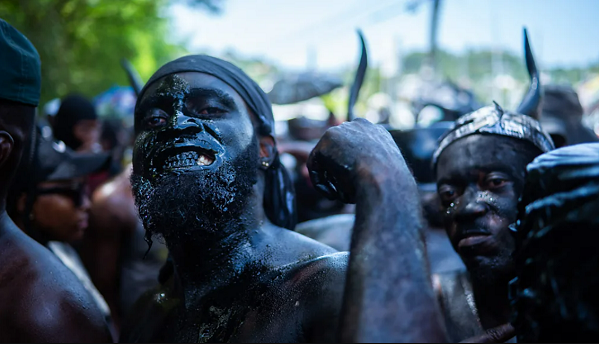
“A year after record-breaking Hurricane Beryl, the Caribbean is still reeling – but on one island, defiant traditions are fueling its climate resilience.” Runako Celina (BBC News) writes, “As a second-generation British-Grenadian returning to join these carnival celebrations a year after Hurricane Beryl, I wanted to take the temperature of the island’s climate resilience. How is Grenada building back after the storm, and where is the country in its longer-term pursuit of climate justice?” [Many thanks to Peter Jordens for bringing this item and the previous Rolling Stone article to our attention.]
In the predawn darkness, the streets are still damp from the night before as thousands gather, ready to parade through St George’s, the capital of the Caribbean nation of Grenada. Chains scrape against the asphalt and horns jut from helmets pointing skyward.
A conch shell sounds, the rallying call that heralds J’Ouvert morning, the official start of carnival, called Spicemas. As dawn breaks, people flood the streets with their bodies blackened with oil and charcoal.
This is Jab Jab, one of Grenada’s oldest carnival traditions, born of emancipation, resilience and resistance. These masqueraders raise chains as symbols of liberation and dress this way to embody the very figures that oppressors of the past once used to demonise them – using mockery and satire to turn insult into power. Its unruliness is deliberate, a rejection of the order once imposed by colonial rule.
That same spirit of defiance is what Grenadians are leaning on today in the face of deep challenges brought by extreme weather. In July 2024, Grenada was left badly damaged when Hurricane Beryl swept over the island and those around it. Fuelled by hot seas, the strongest storms, like Beryl, have arrived earlier and intensified explosively.
As a second-generation British-Grenadian returning to join these carnival celebrations a year after Hurricane Beryl, I wanted to take the temperature of the island’s climate resilience. How is Grenada building back after the storm, and where is the country in its longer-term pursuit of climate justice?
David A Farrell, principal of the Caribbean Institute for Meteorology and Hydrology, says Hurricane Beryl was unlike anything the region had seen. “It became the earliest category five storm on record in the Atlantic, developing when people were still preparing for the season.” For Farrell, it’s a signal that things are shifting. “This suggests that the baseline for the start of the hurricane season may be shifting to earlier in the year and the season getting longer.” [. . .]
For Grenadian environmental lawyer Rosana John, Beryl was more than a meteorological event – it was also a legal and moral one. The average person in Grenada contributes just 2.9 tonnes of CO2 emissions per year, compared with 14.3 tonnes for the average US resident. Over the course of the two countries’ histories, the difference is even starker – Grenada has produced barely 0.002% of the climate-warming CO2 emissions than the US has. “Grenada is paying for a crisis it did not cause,” John says. “We contribute next to nothing in emissions, yet we are the ones facing the destruction of our homes, our livelihoods, our very heritage.” [. . .]
For full article, see https://www.bbc.com/future/article/20250912-the-caribbean-island-defying-the-existential-threat-of-hurricanes
Also read “Grenada’s Carnival is full of African history, resistance, and the some of the world’s best parties,” by Mankaprr Conteh, Rolling Stone, August 23, 2025
https://www.rollingstone.com/music/music-features/made-in-africa-grenada-carnival-history-politics-parties-1235413938
“A year after record-breaking Hurricane Beryl, the Caribbean is still reeling – but on one island, defiant traditions are fueling its climate resilience.” Runako Celina (BBC News) writes, “As a second-generation British-Grenadian returning to join these carnival celebrations a year after Hurricane Beryl, I wanted to take the temperature of the island’s climate resilience. How
